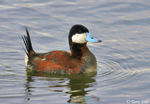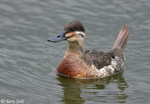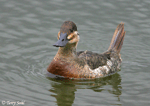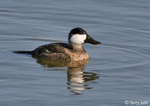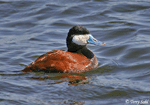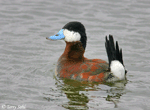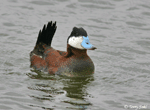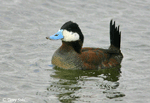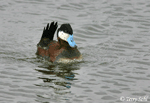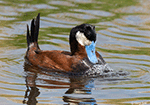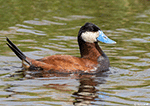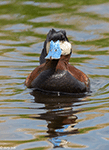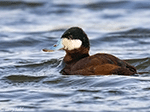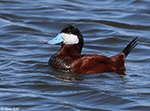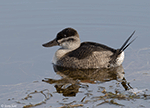| Length: 15 inches | Wingspan: 22 inches | Seasonality: Summer / Migrant |
| ID Keys: Blue bill, black cap, white face, stiff black tail. | ||
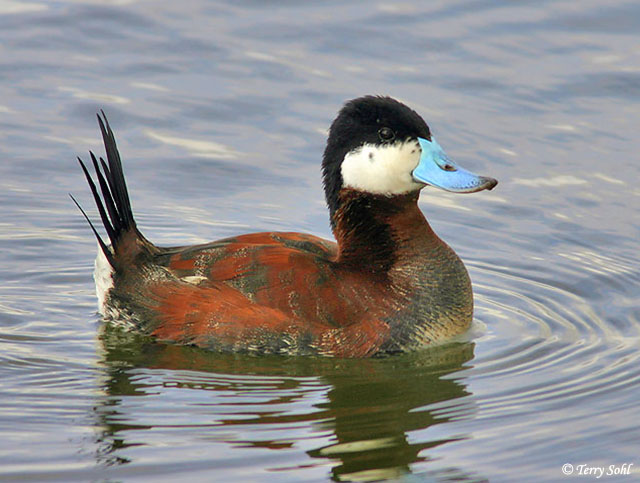 A
unique small duck, readily identifiable by the male's bluish bill (in
breeding plumage), white face, and long, stiff, upright black tail (See
photo at the right). Ruddy Ducks are often reluctant to fly, and when
disturbed, often will sink below the surface and swim away underwater like a
grebe rather than fly away. They are nearly incapable of walking on
land, with legs and feet set very far back on the body. Ruddy Ducks
are generally relatively tame, making the species susceptible to hunting
pressures. From a birding perspective however, they're generally more
approachable than many waterfowl.
A
unique small duck, readily identifiable by the male's bluish bill (in
breeding plumage), white face, and long, stiff, upright black tail (See
photo at the right). Ruddy Ducks are often reluctant to fly, and when
disturbed, often will sink below the surface and swim away underwater like a
grebe rather than fly away. They are nearly incapable of walking on
land, with legs and feet set very far back on the body. Ruddy Ducks
are generally relatively tame, making the species susceptible to hunting
pressures. From a birding perspective however, they're generally more
approachable than many waterfowl.
Habitat:
Breeds on freshwater ponds and lakes with marshy borders. Many winter along coastlines in shallow bays and estuaries, but some may be found inland where open water is available.
Diet:
Seeds, other plant material including roots and leaves, aquatic insects and their larvae, crustaceans, mollusks, occasionally small fish.
Behavior:
Forages by diving and swimming underwater. It uses its bill to pluck mud from the lake bottom, straining the mud to obtain food items contained within.
Nesting:
June and early July in South Dakota. The female builds a bowl-shaped nest of dead cattails, reeds, and other vegetation, placed and anchored in dense wetland vegetation. The nest is usually placed a few inches above the water's surface, and often has surrounding vegetation pulled down over the nest bowl, forming a canopy. The female lays between 4 and 15 eggs, and she alone incubates them. The young hatch after about 24 days. The young leave then nest within a day of hatching and are self-sufficient, feeding themselves and even being capable of diving underwater for safety soon after hatching. However, the female continues to protect them while young.
Song:
Generally silent, with one very noted exception. Ruddy Duck females will sometimes give quiet vocalizations and hisses around the nest, particularly when feeling threatened. However, it's the unique courtship ritual of the male that is most often heard. The males will court and defend territory by raising their tail vertically, placing their bill against their chest, and rapidly slapping the bill on their vibrating chest, typically resulting in frothy bubbling around the male's chest. The display ends with a squawking "belch".
1Click here to hear audio of a male Ruddy Duck courtship display
Migration:
Summers throughout much of the western half of the United States and Canada, locally around the Great Lakes. Summers near both coasts, the southern United States, and points south.
Interactive eBird map:
Click here to access an interactive eBird map of Ruddy Duck sightings
Similar Species:
Male Ruddy Ducks are unlikely to be confused with any other species if seen well. However, if not seen well, or for females and males in non-breeding plumage, there's a greater chance of being confused with other species:
- Bufflehead - It's the female bufflehead that is potentially easiest to confuse with a Ruddy Duck, if not seen well. Female Buffleheads have a white patch on the cheek and dark bill that could be confused with a male Ruddy Duck in non-breeding plumage. However, the head pattern on a non-breeding male Ruddy Duck is more contrasty, with a darker cap above a lighter face and neck. Also, the white facial patch on a non-breeding male Ruddy Duck is much larger than that of a female Bufflehead.
- Female Scoter Species - Female Black, Surf, and White-winged Scoters could potentially be confused with female Ruddy Ducks or possibly non-breeding male Ruddy Ducks. Part of the reason for potential confusion is the bill shape, very different than many other ducks, but somewhat similar between Scoters and Ruddy Ducks. However, all Scoter species are noticeably larger than a Ruddy Duck, and none carry their tail in a vertical fashion as Ruddy Ducks often do.
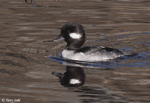 |
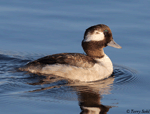 |
| Bufflehead (female) | Bufflehead (female) |
Conservation Status:
There's little doubt Ruddy Ducks are much less common than in 19th century. Hunting and habitat loss led to decreases in both numbers and range. However, their numbers are generally now stable, they're found across a very broad geographic area, and they are common in parts of their range. The IUCN considers the Ruddy Duck to be a species of Least Concern.
Further Information:
Photo Information:
March 25th, 2007 - Minnehaha County, South Dakota - Terry Sohl
Additional Photos:
Click on the image chips or text links below for additional, higher-resolution Ruddy Duck photos.
Audio File Credits:
1Bruce Lagerquist. Recorded in Lake County, Oregon on May 30th, 2019. Original recording and information from xeno-canto.
| Click on the map below for a higher-resolution view |
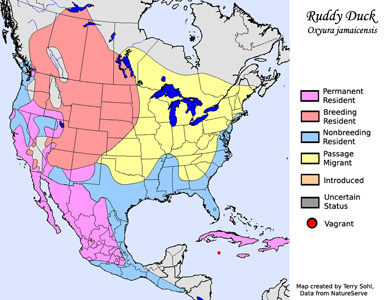 |
| South Dakota Status: Common migrant throughout the state. Common summer resident in the northeastern part of the state, uncommon elsewhere. |
Additional Ruddy Duck Photos
Click for a higher-resolution version of these photos
